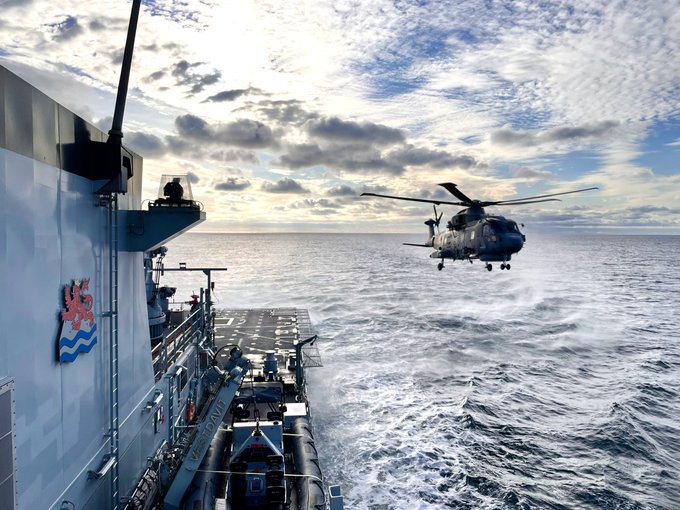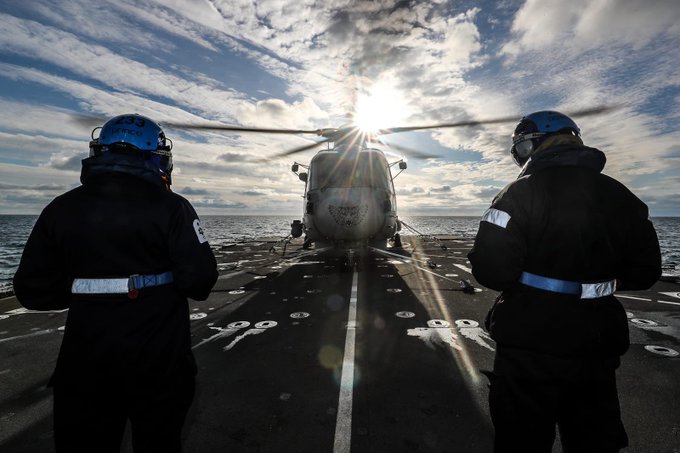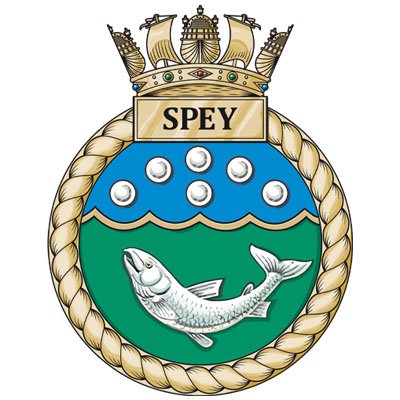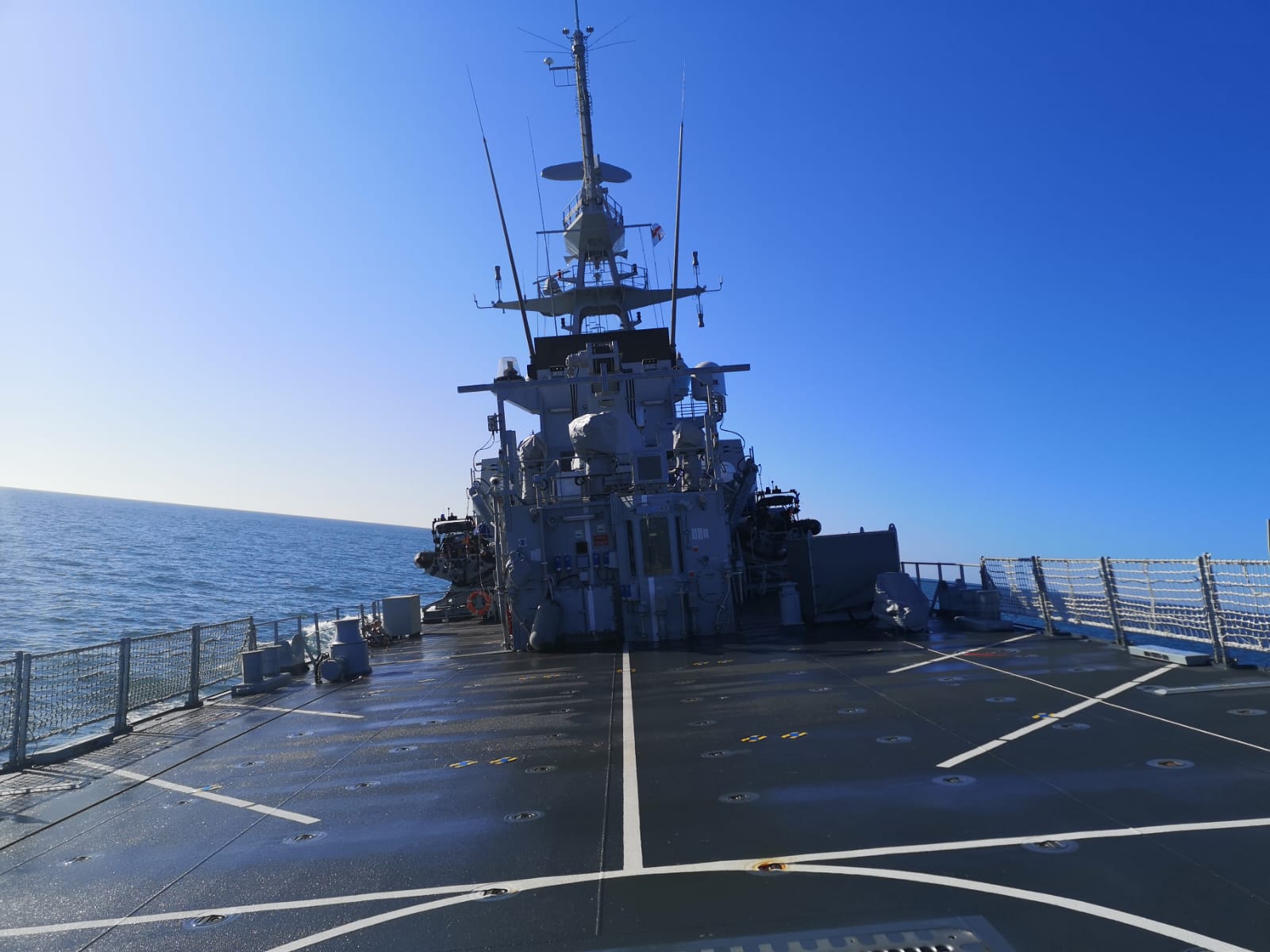River Class (OPV) (RN)
- Tempest414
- Senior Member
- Posts: 5619
- Joined: 04 Jan 2018, 23:39

Re: River Class (OPV) (RN)
As said this was a planned show of force put on by the RN so HMG could say they were taking back control to the unenlightened mob the way I see it playing out is Trent will come back in soon and then deploy back to the Med Tamar like wise will come back in before deploying over seas this will leave the 3 B1's and 3 FPV of the Scotts to carry on as normal
Re: River Class (OPV) (RN)
It also depends on what you mean by control. Conservation decisions are now made, and quota levels are now set, by the UK, they are no longer an European Commission (in)competency - see their decision last week that set quotas in the rEU waters at higher than sustainable levels for seven different species.RichardIC wrote:"Strategic horizon"!!!?Poiuytrewq wrote:RichardIC wrote:
Did they?
It really depends if your strategic horizon is 5 minutes or 5 years.
Absolutely they caved. Strategic horizon doesn't come into it. They got what they were given and failed to take back control.
Do you actually think this is part of a clever plot? Let them think they've won for now and then in five years, when they're not paying attention, we'll have them.
The ban on Pulse fishing was extended from Territorial waters to the whole UK EEZ yesterday (the EU won't ban it until July 2021 and will still allow some Dutch trawlers to continue after that point). In five years time (a not unreasonable amount of time for companies and individuals to re-organise their affairs), the transition period will end and there will be an opportunity to move more of the catch to UK boats, taking UK catch share above the 66% already agreed.
There is also the prospect talk that a ban will be placed on other harmful fishing practices, such as sandeel dredging in the mid-North Sea (a primary food source for many seabirds and other fish), which go mainly to make pig feed for the Danish market.
The pessimist sees difficulty in every opportunity. The optimist sees the opportunity in every difficulty.
Winston Churchill
Winston Churchill
- ArmChairCivvy
- Senior Member
- Posts: 16312
- Joined: 05 May 2015, 21:34

Re: River Class (OPV) (RN)
Who's gonna save my breakfast bacon after that?Caribbean wrote:go mainly to make pig feed for the Danish market
- only half seriously
Ever-lasting truths: Multi-year budgets/ planning by necessity have to address the painful questions; more often than not the Either-Or prevails over Both-And.
If everyone is thinking the same, then someone is not thinking (attributed to Patton)
If everyone is thinking the same, then someone is not thinking (attributed to Patton)
Re: River Class (OPV) (RN)
Set your sights on higher quality stuff raised on better quality feedArmChairCivvy wrote:Who's gonna save my breakfast bacon after that?
Another thing that I'm hoping will happen is that the current consultation will lead to a ban on live animal transport for slaughter to the EU and elsewhere (this is permitted currently in the EU, so the meat can be labelled as being produced in the country of slaughter, rather than where it was raised - there is also good evidence that the UK's animal transport regulations are ignored once the animals are off UK soil)
The pessimist sees difficulty in every opportunity. The optimist sees the opportunity in every difficulty.
Winston Churchill
Winston Churchill
Re: River Class (OPV) (RN)
The BVA/RCVS joint working committee has assurance that all live animal exports excepting horses and breeding animals will stop by 2022. Also, the new planned divergence allows all animal products not meeting farm assured status (Red Tractor) be labelled as non compliant (previously banned by EU law).
Given the UK currently has higher animal welfare standards and the maximum allowed non domestic journey of 10 hours without overnight lairage, I personally think it will stop sooner. This is now reciprocally applicable to import to the UK, excepting NI. As for the obsession with Danish bacon, the UK does some pretty good stuff and having had the misfortune of seeing firsthand the welfare standards of pig farms in EU including Denmark, I pay a bit more for UK farm assured.
Given the UK currently has higher animal welfare standards and the maximum allowed non domestic journey of 10 hours without overnight lairage, I personally think it will stop sooner. This is now reciprocally applicable to import to the UK, excepting NI. As for the obsession with Danish bacon, the UK does some pretty good stuff and having had the misfortune of seeing firsthand the welfare standards of pig farms in EU including Denmark, I pay a bit more for UK farm assured.
Re: River Class (OPV) (RN)
Cant stand the Supermarket Bacon myself, besides the taste, it shrivels to nothing when cooked.Caribbean wrote:I actually gave up eating "danish" bacon (mainly re-badged as UK supermarket brands
-
Tinplate Turleigh
- Junior Member
- Posts: 4
- Joined: 01 Feb 2016, 18:21

Re: River Class (OPV) (RN)
I imagine this very laudable sub topic is in grave danger of being considered "off topic". So, before that happens, two points:
1) Post Brexit trade deals with our American friends opens up the prospect of food imports from the US, of animal products produced under welfare conditions which, shall we say, are quite different from ours. If the generally high welfare standards in the UK are to be maintained then these competing imports will have to be minimal.
2) (More RN related!). Many decades ago I was a junior pen pusher in the Admiralty/MoD(Navy) Victualling department and had the privilege of seeing at first hand the work done in the department's Food Testing Laboratories at the Royal Clarence Yard, Gosport. RN Food quality standards were stated as being amongst the highest in the land - certainly higher than for Joe public. I recently saw a food programme on TV where a well known supermarket was showing off it's "21st century" food testing facilities and procedures - they were nearly identical to the ones I saw taking place at Royal Clarence Yard in the early 1960s! That was a time when people were bemoaning the reducing Fleet size and the RN had "shrunk" to five Fleet carriers and OPV/ small escort type vessels were counted in dozens rather than hundreds.
1) Post Brexit trade deals with our American friends opens up the prospect of food imports from the US, of animal products produced under welfare conditions which, shall we say, are quite different from ours. If the generally high welfare standards in the UK are to be maintained then these competing imports will have to be minimal.
2) (More RN related!). Many decades ago I was a junior pen pusher in the Admiralty/MoD(Navy) Victualling department and had the privilege of seeing at first hand the work done in the department's Food Testing Laboratories at the Royal Clarence Yard, Gosport. RN Food quality standards were stated as being amongst the highest in the land - certainly higher than for Joe public. I recently saw a food programme on TV where a well known supermarket was showing off it's "21st century" food testing facilities and procedures - they were nearly identical to the ones I saw taking place at Royal Clarence Yard in the early 1960s! That was a time when people were bemoaning the reducing Fleet size and the RN had "shrunk" to five Fleet carriers and OPV/ small escort type vessels were counted in dozens rather than hundreds.
- ArmChairCivvy
- Senior Member
- Posts: 16312
- Joined: 05 May 2015, 21:34

Re: River Class (OPV) (RN)
Rivers go in and out of port all the time, but my (unfounded?) impression is that on our subs there is not that much refrigerated space (despite unlimited electricity). Do you happen to know if for e.g. meat the same method as was used for stockpiling in Berlin is used? The irradiated steaks were auctioned off only 12-15 years ago.Tinplate Turleigh wrote:RN Food quality standards were stated as being amongst the highest in the land - certainly higher than for Joe public.
Ever-lasting truths: Multi-year budgets/ planning by necessity have to address the painful questions; more often than not the Either-Or prevails over Both-And.
If everyone is thinking the same, then someone is not thinking (attributed to Patton)
If everyone is thinking the same, then someone is not thinking (attributed to Patton)
-
donald_of_tokyo
- Senior Member
- Posts: 5593
- Joined: 06 May 2015, 13:18

Re: River Class (OPV) (RN)
HMS Forth is now carrying a 20ft ISO container on her flight deck. Not sure if she can handle the SAR helicopter there? (There are also a rigid raider, but it can be easily moved).
SAR helicopter now in use is, as I understand, AW189. It has a rotor diameter of 14.6 m. AW101 Merlin has a rotor diameter of 18.6 m, and HMS Medway has already operated Merlin from her flight deck. So locating a 2.5 m wide ISO container on forward of the flight deck may not prohibit AW189 operations, I guess?
SAR helicopter now in use is, as I understand, AW189. It has a rotor diameter of 14.6 m. AW101 Merlin has a rotor diameter of 18.6 m, and HMS Medway has already operated Merlin from her flight deck. So locating a 2.5 m wide ISO container on forward of the flight deck may not prohibit AW189 operations, I guess?
-
Tinplate Turleigh
- Junior Member
- Posts: 4
- Joined: 01 Feb 2016, 18:21

Re: River Class (OPV) (RN)
ArmChairCivvy,ArmChairCivvy wrote: Do you happen to know if for e.g. meat the same method as was used for stockpiling in Berlin is used? The irradiated steaks were auctioned off only 12-15 years ago.
That's an interesting comment which I haven't heard before (I had nothing to do with the RN food side of things after 1970). Regarding your other point about Rivers being able to top up with food fairly frequently, they still nevertheless have to maintain a certain level of stock on board (30 days or whatever) incase they are suddenly called away on extended operations. Submarine frozen food storage limitations would be more to do with space rather than available power, I would imagine.
-
donald_of_tokyo
- Senior Member
- Posts: 5593
- Joined: 06 May 2015, 13:18

Re: River Class (OPV) (RN)
Merlin onboard HMS Tamar. I was not sure if the "only" ~21-m long "short" flight deck of River B2 OPV can efficiently operate Merlin. But, HMS Medway and Tamar shows that, at least when the sea is relatively calm, it is easy. Good news.


from
"" and ""


from
"" and ""
-
donald_of_tokyo
- Senior Member
- Posts: 5593
- Joined: 06 May 2015, 13:18

Re: River Class (OPV) (RN)
Makes a lot of sense allowing them to interrogate radar contacts over a wide area, be they Spanish or French. 
- Tempest414
- Senior Member
- Posts: 5619
- Joined: 04 Jan 2018, 23:39

Re: River Class (OPV) (RN)
Its a start and would allow eyes on for ships command but its limited range 15 km and time 2 hours is some what poordonald_of_tokyo wrote:Good news.
Two sets of Puma light UAVs are in trial onboard HMS Tamar.
-
donald_of_tokyo
- Senior Member
- Posts: 5593
- Joined: 06 May 2015, 13:18

Re: River Class (OPV) (RN)
Not a big issue. Puma light UAVs are light UAVs. As these UAV are very cheap and handy to operate, they have their own place. Very good place. It is just an asset "similar to eyeball Mk 1 high in the air".Tempest414 wrote:Its a start and would allow eyes on for ships command but its limited range 15 km and time 2 hours is some what poordonald_of_tokyo wrote:Good news.
Two sets of Puma light UAVs are in trial onboard HMS Tamar...
Of course, larger system are also envisaged, such as CAMPTOPTER or AW Hero (200 kg rotary UAV, both can go 6-6.5hr in the sky with 30-35 kg payload). Surely they are much capable than Puma light UAVs, but also surely much more expensive.
We can even go as far as MQ-8B, an 1.4t system with typical endurance of 8 hrs.
But, using MQ-8B, or even CAMPTOPTER or AW Hero might be "too expensive" for many (if not all) of the fishery protection roles, in which case Puma light UAVs is a good solution.
Re: River Class (OPV) (RN)
HMS Spey (P234) commissioned


(Ross Watton Ship Paintings) https://www.rosswatton.com/photo_16682244.html


(Ross Watton Ship Paintings) https://www.rosswatton.com/photo_16682244.html
Re: River Class (OPV) (RN)
Looking forward to a photo op off Kingston at Spey Bay soon. Just a pity we're on lock down now so I'd miss it.
- Tempest414
- Senior Member
- Posts: 5619
- Joined: 04 Jan 2018, 23:39

Re: River Class (OPV) (RN)
My point is more that if Puma could be given a range of 30km+ it would be a good start there is work going on to give Puma 5 hours flight time so if the range could be increased it would be more usefuldonald_of_tokyo wrote:Not a big issue. Puma light UAVs are light UAVs. As these UAV are very cheap and handy to operate, they have their own place. Very good place. It is just an asset "similar to eyeball Mk 1 high in the air".Tempest414 wrote:Its a start and would allow eyes on for ships command but its limited range 15 km and time 2 hours is some what poordonald_of_tokyo wrote:Good news.
Two sets of Puma light UAVs are in trial onboard HMS Tamar...
Of course, larger system are also envisaged, such as CAMPTOPTER or AW Hero (200 kg rotary UAV, both can go 6-6.5hr in the sky with 30-35 kg payload). Surely they are much capable than Puma light UAVs, but also surely much more expensive.
We can even go as far as MQ-8B, an 1.4t system with typical endurance of 8 hrs.
But, using MQ-8B, or even CAMPTOPTER or AW Hero might be "too expensive" for many (if not all) of the fishery protection roles, in which case Puma light UAVs is a good solution.
-
donald_of_tokyo
- Senior Member
- Posts: 5593
- Joined: 06 May 2015, 13:18

Re: River Class (OPV) (RN)
Thanks, No objection. But, as Puma is cheap and handy (which is the only merit of these light UAVs), these "improvements" can be done "along the way". So called "spiral development". Actually, operational know how, good tactics, weather condition decision, many things are needed to be done. Delaying its introduction hoping for "slightly better" version will just make things worse.Tempest414 wrote:My point is more that if Puma could be given a range of 30km+ it would be a good start there is work going on to give Puma 5 hours flight time so if the range could be increased it would be more useful
I think RN must start now. Purchase 50 systems of Puma UAV, deploy 2-sets each to
- 8 OPVs (16 sets)
- 10 active escorts (20 sets)
- 4 LPD/LSDs (8 sets)
+ training etc.
I'm afraid "mission loss" may happen so so frequently (because of sudden weather change, recovery failure, machinery malfunction. No problem, Puma is cheap for these reason).
Use them intensively to rapidly develop the tactics = make those UAV assets "essential" in all surface vessels. If newer longer range version (say, block-2) comes in, buy 40 of them, and deploy 4-sets of old version and 2-sets of new version each to
- 8 OPVs (4 sets each of the old block-1 UAV 32 sets)
- 10 active escorts (2-sets of the new block-2 UAV20 sets)
- 4 LPD/LSDs (2-sets of the new block-2 UAV8 sets)
+ training etc.
Still it is not a big issue, because Puma is not so expensive.
As I understand, high loss rate of Scan Eagle was an issue. Scan Eagle was "cheaper", but not cheap enough to tolerate high loss. So, more reliable long-range land-based UAV is preferred, and rotary-wing UAV is extensively under development. These are more overlapping with Wildcat, and not with Puma UAV.
Re: River Class (OPV) (RN)
I think that's the comms link range, rather than the aircraft range. There is also an LE version that can take different antennas (for up to 60km link range) and larger battery, for up to 6.5 hours at 24kt (max speed 41kts)Tempest414 wrote:its limited range 15 km and time 2 hours is some what poor
The pessimist sees difficulty in every opportunity. The optimist sees the opportunity in every difficulty.
Winston Churchill
Winston Churchill
-
donald_of_tokyo
- Senior Member
- Posts: 5593
- Joined: 06 May 2015, 13:18

Re: River Class (OPV) (RN)
Navy article on UAV Puma on board HMS Tamar.
Points notable for me are;
Puma can survey an area of up to 270 square miles of ocean ... looking for suspicious activity during sorties lasting up to 2.5 hours.
...
We were often flying out of line of sight to approach vessels, using the system’s cameras for identification purposes.
...
Puma is relatively cheap – certainly much cheaper than sending a helicopter up – easy to launch and recover, is difficult for foes to spot and keeps the ship out of harm’s way. In short, Puma gave Tamar ‘eyes in the sky’.
...
Constabulary duties – counter piracy/terrorism/smuggling – are a key role of the new River-class ships.
Typically the vessels will work with Royal Marines boarding teams – a 50-man mess has been built into the ships to accommodate them.
But there may be occasions when Tamar may be called on to work with local law enforcement agencies (such as her sister HMS Medway has been doing in the Caribbean, striking at drug-runners with the US Coast Guard).
https://www.royalnavy.mod.uk/news-and-l ... mar-drones
Points notable for me are;
Puma can survey an area of up to 270 square miles of ocean ... looking for suspicious activity during sorties lasting up to 2.5 hours.
...
We were often flying out of line of sight to approach vessels, using the system’s cameras for identification purposes.
...
Puma is relatively cheap – certainly much cheaper than sending a helicopter up – easy to launch and recover, is difficult for foes to spot and keeps the ship out of harm’s way. In short, Puma gave Tamar ‘eyes in the sky’.
...
Constabulary duties – counter piracy/terrorism/smuggling – are a key role of the new River-class ships.
Typically the vessels will work with Royal Marines boarding teams – a 50-man mess has been built into the ships to accommodate them.
But there may be occasions when Tamar may be called on to work with local law enforcement agencies (such as her sister HMS Medway has been doing in the Caribbean, striking at drug-runners with the US Coast Guard).
https://www.royalnavy.mod.uk/news-and-l ... mar-drones
Re: River Class (OPV) (RN)
An interesting bit towards the end about using Tamar as a "command and control" vessel for Police RHIBS operating in the channel.
It seems that thre's a lot of stuff being quietly trialled at the moment. From the comment about difficulties operating in the "choppy Channel", could the Met be in line for something a bit larger than RHIBS, to push their operational area out a bit further offshore?The combined training with the Metropolitan Police in the Channel proved extremely useful for both the Navy and UK’s largest police force.
The Met used Tamar as their ‘floating headquarters’, turning her into a command and control vessel to marshal their RIB speed boats.
The latter are used to the sheltered waters of the Thames – their normal domain ends at Dartford Creek – and found operating in the choppy Channel rather difficult.
The pessimist sees difficulty in every opportunity. The optimist sees the opportunity in every difficulty.
Winston Churchill
Winston Churchill
- The Armchair Soldier
- Site Admin
- Posts: 1755
- Joined: 29 Apr 2015, 08:31
- Contact:

- Tempest414
- Senior Member
- Posts: 5619
- Joined: 04 Jan 2018, 23:39

Re: River Class (OPV) (RN)
It is a great shot of 3 of the 5 B2's now a shot of the 3 B1's & 2's together would be something to see
-
donald_of_tokyo
- Senior Member
- Posts: 5593
- Joined: 06 May 2015, 13:18

Re: River Class (OPV) (RN)
Flight deck / ISO container deck of HMS Spey. ("")
Can clearly see the 20ft ISO container lashing position marked with yellow and blue. Three 20ft containers aligned to bow-stern, and another one abeam (right after the fli-co room). In total, four of them can be held on the (flight) deck, in addition to the two = one each on both sides of the waist. 6 20 ft ISO container is so-so impressive.
I'm also wondering if the containers can be "double decked" = carrying in total 12 units?
Can these lashing points be used also for holding the "beds" for USVs?
Or, can it be used for "bold on" additional armaments, from StarStreak/LMM 3-tube launcher, RC Simbad for MISTRAL missiles, or even a 20 mm CIWS, and of course, containerized AW Hero UAV system (or any UAV much smaller)? Looks promising.

Can clearly see the 20ft ISO container lashing position marked with yellow and blue. Three 20ft containers aligned to bow-stern, and another one abeam (right after the fli-co room). In total, four of them can be held on the (flight) deck, in addition to the two = one each on both sides of the waist. 6 20 ft ISO container is so-so impressive.
I'm also wondering if the containers can be "double decked" = carrying in total 12 units?
Can these lashing points be used also for holding the "beds" for USVs?
Or, can it be used for "bold on" additional armaments, from StarStreak/LMM 3-tube launcher, RC Simbad for MISTRAL missiles, or even a 20 mm CIWS, and of course, containerized AW Hero UAV system (or any UAV much smaller)? Looks promising.


